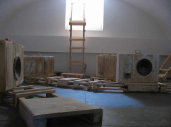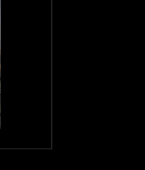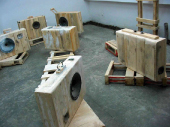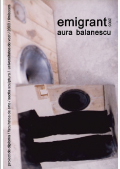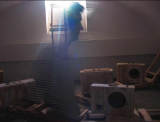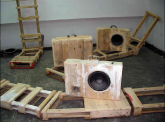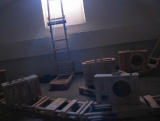9 wood suitcases, empty on the inside, with
incorporated loudspeakers, 1 PC, 1 audio station, 4 luminous signals, horizontal/
vertical routes, made of wood;
required space: 5x5x2.5
the project is constructed of 2 components:
1. a material one, that tries a spatial description and has as elements: 9
suitcases, horizontal and vertical routes
2. a temporal one, like a computer soft, the soundtrack and the luminous signals
1. Starting with the proposed issue, "Emigrant
Communities in the Occident", I asked myself what could be the most simple
reduction of someone who denies his/her own identity and chooses the exile.
The result was: "the travelling suitcase", the externalized but
also internal form of those who pick up this road, the object containing the
few "necessary changes" for the future time of settling in the new
space and also the memories connected to the cherished ones left at home.
A symbol for moving from one place to another, for instability, for the temporary
"denial" of the idea of "home" (therefore the denial of
one's own forced limit, within which life goes on following one's rules) -
the suitcase is the element to compensate for all this space and time delineating
(anchorage) of the individual, it's the element to accompany the (temporary
or permanent) passing from a system to another, on a psychical level.
Formally, I tried to take this prop element out of use, firstly with the material
chosen, the plank, which closes perfectly the form, not allowing any kind
of opening of this object. Also, I depersonalized the object, transforming
it in a mass-produced object, that could better underline this dramatic existential
approach, a dramatic approach not so much individually, but as a mass phenomenon.
The suitcases are suspended along some routes, and this underlines the state
of provisional, of mobile ground which can change its look anytime, of passing
space and not one for staying.
Horizontal routes, modulating like a railroad; mounting and descending routes
- becoming vertical; the "railroad" transforming into a "stair".
The horizontal route is dense like its structure, the vertical one becomes
more airy, like its medium, and the stairs are fewer, harder to climb, inaccessible.
On the horizontal level, a knot of moving is being traced, with no clear marks
for orientation. The modules composing the trajectory have a mobile construction,
like switches, that can be grouped differently at any time, re-orienting the
person who's moving, underlying the state of chaos, indecision, crowd.
In this context, one enters a territory of risk, adventure, a zone of "foreignness",
where the familiar reference points are missing. A limit is created spatially,
in the sense of moving, but this space also transcends the material into the
spiritual through the advancing on the vertical - the stair mounting to the
eye window.
The character is collective, hard to orientate. The suitcases tend to escape
the horizontal route; they are caught between the two dimensions (horizontal/
vertical), and formally they are reflected through a play between these two
dimensions, between the finished appearance of the first dimension and the
non-finished of the second.
2. Why loudspeakers incorporated in the suitcases? The first thought was to
make these objects, apparently empty, alive, using strong sound signals that,
using a sensors device, react at the passing of someone next to them. Let's
not forget that for a long time the passing of the border to the way of exile
were made illegally, taking the risk of loud alarms, that created the state
of fear, risk at the illegal crossing of the rules and borders.
The soundtrack is made of modules of sounds that repeat in time, with interstices
of silence. Like an ancient choir, they seem to comment the told stories,
lacking actually the narration. The luminous signals I've used are the pulsing,
alive element.

